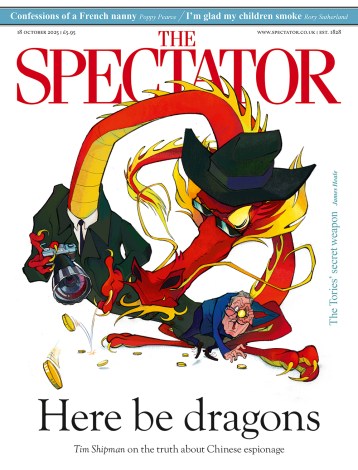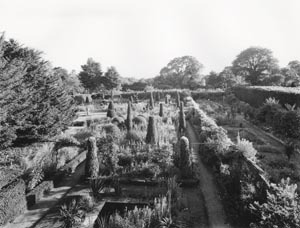Norah Lindsay had wit, beauty and a bohemian spirit. Diana Cooper described her dressing ‘mostly in tinsel and leopard skins and baroque pearls and emeralds’. At Sutton Courtenay, the house where she lived through the early years of her marriage to Harry Lindsay, she entertained non-stop. Raymond Asquith, Julian and Billy Grenfell, Maurice Baring and Jasper Ridley all flocked to her table from Oxford. ‘Sutton Courtenay, roses, the river and the youth of England splashing in the Thames and Norah, the sublime Norah,’ wrote Chips Channon. She was never out of love, often with several young men at a time. ‘Norah sometimes vexes me,’ wrote her sister Madeline Whitbread. ‘How can one thoroughly enjoy oneself and at the same time imagine oneself heartbroken and pining. But I cannot think you can be really heartbroken and be as joyous and gay and interested in heaps of men, clothes, going out, etc.’
Like all life-enhancers, Mrs Lindsay must have been exhausting to live with and when her marriage broke up she stayed on at the beautiful manor house by the Thames, where she continued to make a garden that was as talked about as her clothes and her lavish parties. The laissez-faire style she favoured in the borders was unusual at a time when bright and tidy flowers were more the thing. Her plants were allowed to spill and flop and she gardened on a generous scale. ‘Then here [spoken in a Somerset burr by a puzzled gardener] Mrs Lindsay wants lilies, lazily lolling’ is a joke that is still told at Mells. For her, a garden was, as Rousseau claimed, a mood. ‘Some gardens, like some people,’ she wrote, ‘have a charm to enslave and yet are as intangible as dew or vapour…’
By 1920 the estranged Lindsays were on their uppers. The house had to be let for long periods and everything but the Manor House was finally auctioned. ‘No husband, no money, no home,’ Norah wrote to a friend and in the visitors’ book at Faringdon her entry reads, ‘Norah Lindsay of no address’. But she whirled about with friends all over Europe and continued to garden whenever the house at Sutton was tenant-free. While she was homeless, friends were kind and in return she helped them with their gardens. It was at Mells, with Frances Horner, that she first realised that her advice was worth something and that this was something she might do to provide an income for herself.
At 51 Norah Lindsay turned professional and began to charge her friends for her services. She worked for the Astors at Cliveden, Sir Philip Sassoon at Trent and for the Prince of Wales at Fort Belvedere. Worked was the word. Even in her seventies she would start the day at five, poring over plant lists in bed and then outside all day. ‘The truth is having to stand in the rain two days running and then sleeping in an icy room with all the radiators cut off made me too abominably frozen for words,’ she wrote from St Jean in France. Often her clients gardened with her. The Prince of Wales, in dirty trousers and dusty shoes, ‘is iron made and as alert as a robin,’ she wrote. He rushes about from 10 o’clock until 2 o’clock and then from 3 o’clock until 5 o’clock without pausing to take a breath.’
The physical work she often found less demanding than turning professional. ‘I am nervous and diffident under my brazen shell and really dislike being a professional and at the mercy of criticism more than I can say,’ she wrote to Philip Sassoon, who became a real friend. Sending bills was odious, especially to Nancy Astor, who tended to query everything, and she hated spending evenings with total strangers, with ‘quite nice houses and quite nasty gardens’. She confided to Sassoon, ‘I’m getting a horrible “sweet smile” on my face like being a lady-in-waiting. Anyhow, I say to myself — I’m only here for three days, then back at Sutton and shall spend all my time lying in bed and playing the piano.’
Lawrence Johnston of Hidcote became a great friend and her influence on him was strong. Of his garden in the south of France, Serre de la Madone, she complained that it was spoilt by treillage, tricks, too many tiny pots and new doors with fat babies on them. ‘There’s no design, it’s too tricky about with tiny paths and tiny rocks and tiny sitting places — it wants all simplifying and pushing out in all directions.’ Her eye for space and architecture was as good as her taste in plants.
As a gardener, Norah Lindsay was probably one of our greatest. The Long Garden at Sutton has more atmosphere in black and white than any modern glycerine-drenched, shot-at-dawn photograph. Her best legacies were the way she introduced clipped shapes of box and yew into gardens and her sense of scale and generous planting — ‘all head gardeners dote on dots,’ she said. She used painted blue wood long before Titchmarsh and her knowledge of plants was learned the hard way. By train she travelled to Hilliers to choose shrubs (‘when I die Magnolia will be written on my heart’). Although she could fill a bowl indoors with yellow broom, scarlet poppies and delphiniums and occasionally planted salmon pink gladiolus, red-hot pokers, dahlias and gazanias, what she loved best was a colour scheme based on ‘ton sur ton’. It has taken an American to recognise Norah Lindsay’s worth and Allyson Hayward has done her proud. I only had one regret: if Vita Sackville West was really a lifelong friend, as the author claims, how come we never hear of her until two years before Norah Lindsay’s death in a rather stiff letter of condolence? So many of the features at Sissinghurst have touches of Lindsay’s flair that some proof of their pooling ideas would have made the book even more fascinating.






Comments